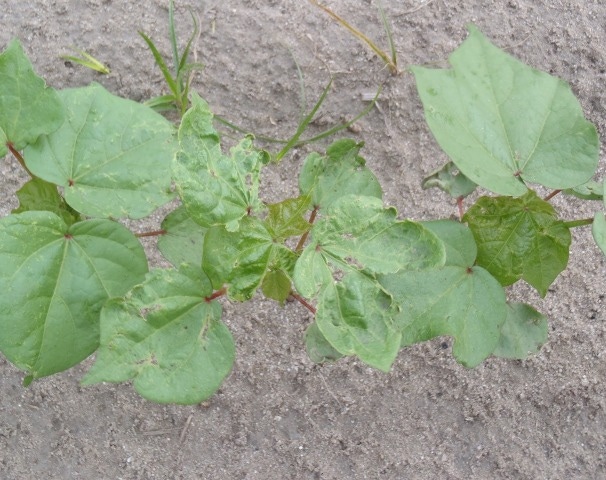April 7, 2015

Considering certain risk factors can give producers a heads-up when it comes to controlling thrips on cotton.
Several years ago, Georgia initiated a risk index for tomato spotted wilt in peanuts. It has evolved over time into Peanut Rx, a comprehensive disease management program, says Phillip Roberts, University of Georgia Extension entomologist.
“Tomato spotted wilt virus is transmitted by thrips, so producing peanuts in an environment of fewer thrips helps growers manage this virus. When you look at that risk index in terms of cultural practices, there are two that have a significant impact on thrips. No. 1 is planting date and No. 2 is tillage practice, and these are equally important in managing thrips on cotton,” he says.
Roberts notes that data from the past 14 years reveals a recent increase in oversprays for thrips in Georgia cotton.
“In recent years, we’ve tended to make more oversprays, and part of this is due to the fact that we were heavy Temik users back in the early 2000s. We’ve tended to spray more acres with foliar insecticides in the last couple of years,” he says.
Researchers in Georgia, says Roberts, are initiating intensive trials to try and better understand the impact of planting date on thrips in cotton.
“We’re focusing on the number of thrips per individual plant at two weeks after planting. With an April 10 planting, we had about two thrips per plant. The data shows that we typically experience our highest thrips population when we plant into April and the first part of May. As we get into the last part of May and the first part of June, our thrips numbers are reduced greatly,” he says.
In Georgia, about 35 to 40 percent of cotton acres are planted in the window high thrips populations are expected.
There are a lot of different studies in terms of how tillage practices affect thrips populations, he says.
“The main point is that thrips populations are much lower when we have soil residue on the surface. In the last couple of years in Georgia, one of the best thrips treatments I observed was a rolled rye. We had very thick rye cover, and it looked as good if not better than many of our insecticide treatments.”
Looking at risk factors
In determining risk groups, Roberts analyzed trials with two common treatments. “We focused on a seed treatment, imidacloprid or thiamethoxam, and also treatments where we had a foliar application of acephate or some other thrips insecticide at the one leaf stage, in addition to the seed treatment.”
He looked at 26 trials over the past 14 years with those treatments in common, along with the cultural methods involved in the trials.
“I was able to identify planting date as well as tillage practice, and I grouped the trials into two risk groups, a high-risk and a low-risk group. A high-risk category was cotton planted prior to May 10 in a conventional tillage system. If it was a reduced-tillage system or planted after May 10, we put it in the low-risk group. Then, we simply compared the yields between the risk groups.”
“Not many trials were planted in a low-risk environment. Most of the time, these trials were being placed so we could measure the efficacy of products, so we tried to place them in an environment with a lot of thrips. In almost every situation, yields were greater with seed treatments compared to where we did nothing.
“On average, we saw a yield response of about 120 pounds in the low-risk environment. On average, we saw a yield response of almost 280 pounds in a high-risk environment. We also pulled thrips populations from those trials, per five plants three weeks after planting. There are very few thrips in the low-risk environment and about four or five times that number in the high-risk environment.”
Roberts says Extension also wants to be able to advise grower when and if they need to supplement seed treatments with a foliar spray.
“So we looked at the response of a foliar spray of acephate on top of a seed treatment. In the low-risk environment, with the addition of Orthene or acephate to the seed treatment, we saw an average yield response of 13 pounds, which isn’t really significant. In the high-risk environment, we saw an average yield response of about 95 pounds per acre. It’s pretty significant that we’d see such a consistent yield response in these high-risk environments.”
Roberts encourages growers to give more thought to managing thrips in cotton.
“Southeast entomologists are working to come up with a more powerful model to help us understand this risk, so maybe we can be more precise with our treatments We encourage growers to use a seed treatment at planting or some type of systemic as a preventive treatment. We know that we’ll need to supplement these seed treatments in some years. But consider these risk factors – planting date and tillage. That can give growers a heads-up as to what to expect.”
One of the primary problems in Georgia is that the majority of the cotton that is oversprayed is the crop that’s planted early.
“When we need to be overspraying our cotton, we’re planting the rest of our cotton. It’s difficult to do on the farm level, but it can help growers plan to a degree.”
About the Author(s)
You May Also Like




